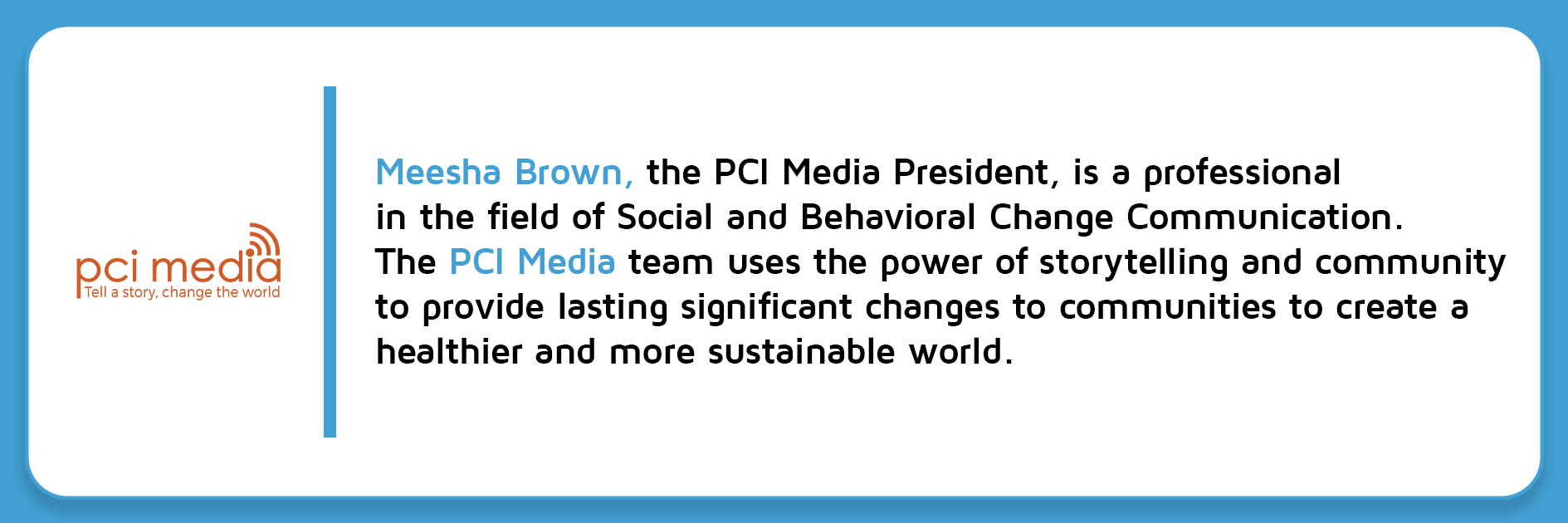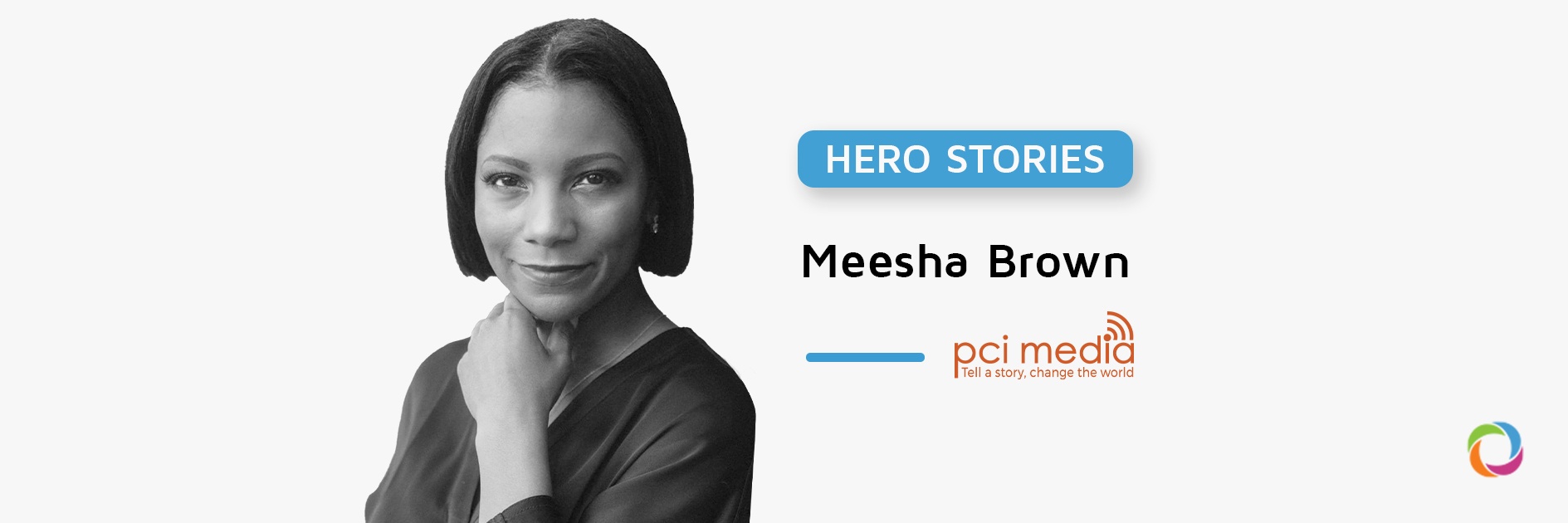A strong empathetic woman committed to changing the world, Meesha Brown believes in the power of storytelling to facilitate and sustain change and has conducted resonance communication campaigns across the world. Meesha, along with her team at PCI Media, engages with the most diverse and complex audiences to open up space for dialogue and action. Communication during COVID, ineffective approaches, the prize for the “#ISurvivedEbola” campaign, radio dramas, and behavioral change – you will find them all in this DevelopmentAid Hero Stories interview. Meet Meesha Brown, the President of PCI Media, the company that uses the power of storytelling and community to bring about social change around the world.
COVID-19 communication – total mess
Communication during the COVID-19 period has been a total mess. I know this is not a very diplomatic way of putting it, but we are two years in and there’s no other way to say it. We have been very surprised that most of the communication efforts around COVID were what I would call a social marketing approach. PCI Media almost never uses social marketing alone, unless as part of a more comprehensive strategy, but what I am concerned about is that the resources that could have gone to more effective communication around COVID, its prevention and vaccination, were used on approaches that are not effective. We see they are not effective because of the continued spread of the virus and also because of the very low vaccination rates, even in places where the vaccine is widely available.
Technically accurate messages are not always the best play
I think the biggest mistake has been perceiving technically accurate messaging to be effective messaging and then using this. So these are the things that the “#ISurvivedEbola” campaign taught me to communicate in an emergency. Yes, medical science needs to drive the messaging but communication science needs to drive how the message is actually communicated. When I first landed in Western Africa during the Ebola epidemic there was a billboard that said: “Come to the clinic, there is no cure!” That is technically accurate but what does that actually communicate to a person? Again, if we think about how we reach people, that message was saying to a lot of people, “Stay home! Because even if I go to the hospital, they are not going to help me and I am going to die there, and I would rather die with the people I love”. So, how do we get to a place where we have information that is accurate and it also resonates with people and does two important things: gives them hope and empowers them to act? I don’t think we’ve done either of those things with COVID.
Stories of hope needed to replace panic and hopelessness
These are emotions that feed on themselves in a vicious cycle that is difficult to get out of. We do need stories of hope. And again, if you think what is in the news media right now, even what some politicians choose to highlight, are the stories that all the hospitals are overrun, and here are all the people that are dying, and here are all the horrible things that are going to happen to you if you don’t get vaccinated. Yes, all of that is true, but also there are millions of people in the world who are protecting themselves and their families who are not contracting the disease, who have had the vaccines and are perfectly healthy – and we need those stories.

Coercive messages will never boost vaccination
Three years before COVID happened I was talking to a team at the School of Public Health at New York University about vaccination in general and how typically society has encouraged people to be vaccinated through coercion measures: “if you want your children to go to school…”, “if you want to come to this place…”, “you have to be vaccinated”. I am not a fan of coercion and these are all forms of coercion. Firstly, if people don’t find enough incentive they will not follow the recommendations and they just won’t do it and, secondly, it erodes trust over time. People feel manipulated and controlled. When you talk to people who do not want to have the vaccine, it is typically because they have questions or they have concerns or they have long-standing norms and ideas. But, if we consider how behaviour change happens, if they were given the space to discuss this with no judgment being made and with support, they’re more likely to make changes of behaviour.
Communications need to be realistic to the lives of actual people
For the “stay at home” messaging at the very beginning of the pandemic, in the US there was a big focus on celebrity ambassadors for this type of messages. People were very upset because it is very easy for these wealthy people to stay at home because they have large, beautiful houses and they can do their work from home, but what about people like me? This does not make sense for me. And at the beginning of COVID, people were asked to give up their livelihoods, wondered how their children were going to go to school. And I know it was an emergency situation and these things are always difficult, but we have to get better at taking time to consider the people who we want to reach and the reality of their lives and use that to inform the communications that we provide.
90% of listeners report changes in their knowledge
We are going into our eighth season of a long-running communication program called “Ouro Negro” in Mozambique with our partners, UNICEF and the Ministry of Health. We are now reaching four million people per year and 90% of our listeners report changes in their knowledge. They know how to live healthier, there is no stigma associated with certain behaviors, they are supporting their wives to have healthier pregnancies, they are getting immunisation for their children, they are using COVID prevention practices. 90% is amazing, right? So what if we take this model, which is a successful one, and replicate it in three different places, even in the most complex areas? I want to triple our impact in the next five years.
80% of communications programs involve radio dramas
Radio is still the number one way to reach people around the world. When we say communications or entertainment education, people immediately think television but really it is radio. We air 15 to 30 minutes radio dramas in an hour-long block. The radio host facilitates the conversation about the drama, what happened in the drama, what the characters did, what issues they struggled with. We always invite a guest to the show who will stimulate the discussions so maybe it is a doctor or a mother who has immunised all of her children or the head of a local sustainable fishing organization talking about conservation.
Communication is about creating the space for people to think differently
So, we create that space for dialogue and if we can facilitate a group conversation, then people are more likely to learn. When you and I are on the radio and you’re asking me questions and I am answering, everyone who’s listening, they’re putting themselves in your shoes. So, they are asking the questions and this scales up engagement. We just have to have a few people calling in and lots of listeners and we are really able to scale up the engagement and learning. When we addressed early marriages in the “Ouro Negro” radio drama in Mozambique, people started calling in and saying, “why are these people on this show not letting their daughters get married? They are never going to marry their daughters.” The radio hosts were saying that is not they will never get married, they are just delaying the marriage. People were calling back and saying, “Oh, I have never thought like that. It never occurred to me that we can marry later.” We all live with a script, we eat food that our family eats, we wear the clothes the same way, you know, we all live in a way we think we’re supposed to and what communications can do is to create the space for people to think in a different way and really consider it and with no judgement, no coercion, so that they can come to terms with it. And that is exactly what happened with “Ouro Negro” in Mozambique when people were calling and saying, we can think about things differently. It is okay, our daughters can finish school first and then we can think about marriage. When people decide they want to live better lives – that’s what they do.

Communication goes hand in hand with research
Sometimes, people think of communications as something soft, fuzzy, nice, but it is a science as well. And I like to remind people, even in communications there is a body of theory and research. We are working on maternal health for example – we bring the best expertise to the table about that issue; we also bring expertise to the table about the local context; and the best thinking about the communications theory. What the research does is to really inform what the coalition of actors is that we need to bring together to make a change. So, for example, if it’s maternal and newborn child health there is probably going to be the Ministry of Health, an agency like UNICEF, but also faith communities, or women’s groups or other people who need to be involved to make sure that there will be outcomes we want that reach the communities we want to.
Conversation needs to belong to the people
Let’s go back to Mozambique or Tanzania. I am not Mozambican, I am not Tanzanian. I understand that we are guests in other people’s homes. In the end, it needs to be owned locally so whether we are making a radio drama or a television show or a social media campaign, or a multiplatform campaign, all the aspects have been decided together in the design workshop.
Legacy of PCI Media
Communication for PCI Media is really a way of reaching, inspiring, and educating people. I wake up every morning and I am so excited because of the way we, PCI Media, do our work – we are having conversations with our audiences and we do get to hear back from them. We work in three areas. The first is healthy living and the issues we work on are non-communicable diseases (like Ebola or COVID), maternal, newborn, and child health, etc. Then we have a livable planet portfolio where we work on climate change adaptation, coastal resilience, sustainable fishing, forest preservation, species conservation, and clear air, water, and land. And finally, we have our empower people portfolio which is all about rights and access for marginalized communities, women and girls, LGBTQ communities, migrants, and refugees.
We really need great partners
So how do we build communication programs that advocate for rights and access for these vulnerable communities so they can have full access to their human rights and flourish?
We bring our own expertise to the table, but we need to be partnered with other organizations who want to make the same kind of change and bring additional expertise. One thing that we really focus on is creating strategic partnerships with development aid agencies, funding governments, regional bodies in developing regions like West Africa, East Africa, and Latin America, other NGOs, stakeholders, etc. One of the things that we do know is that we cannot do this alone. Sustainable change is going to happen if we work with other organizations and agencies that have the same vision for the future that we do.


